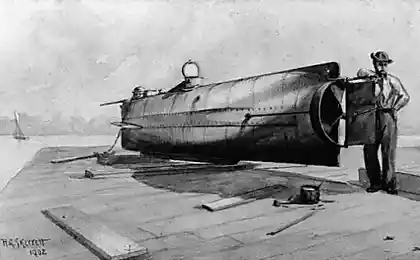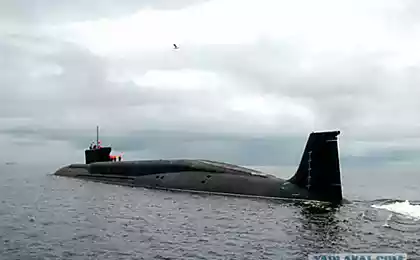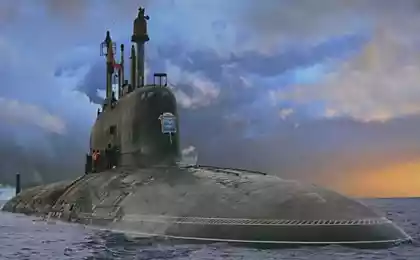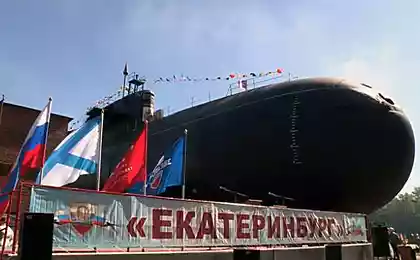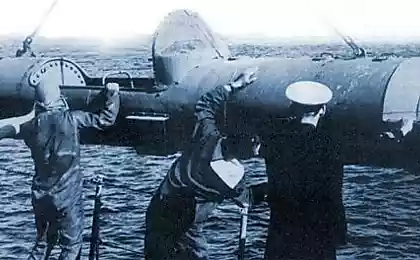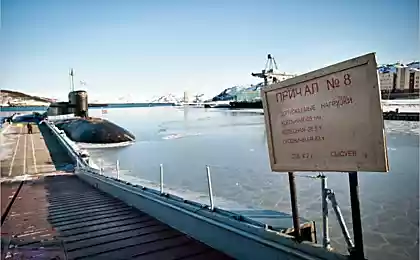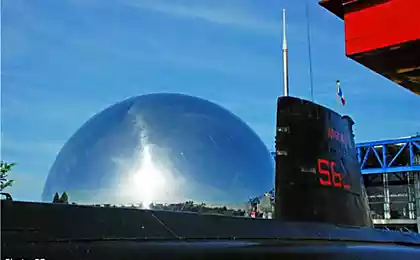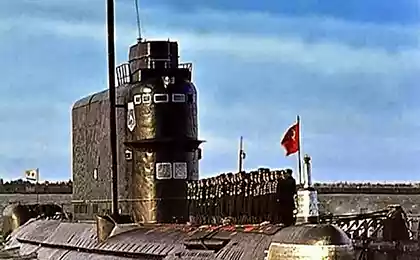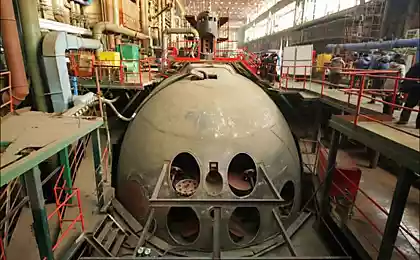1366
Submarine B-396
It turns out that in Moscow there is a diesel submarine, open to the public (of which we have heard in the April post Jus'a).
A detailed photo report on the visit of the submarine by blogger Frantsuzova Denis.
In 2006, the year in the Northern Tushino on the banks of the Khimki reservoir was opened museum, located in this diesel-electric submarine with hull number B-396 641-B of the project, he served from 1981 in the battle of the Northern Fleet.
The boat was built in 1980 at the plant "Red Sormovo" in Nizhny Novgorod.
Its surface displacement - 2770 tons, underwater - 3,600 tons.
Length - 90, 2 m, width - 8, 6 m, draft of 5, 7 m.

During duty committed war patrol boat in the Mediterranean Sea, and patrolled by Soviet and Russian borders in the Barents and Norwegian Seas, was repeatedly named the best ship of the Northern Fleet.
After her write-off in 1998 from the Navy the ship was bought by the Moscow authorities, together with the escort ship "Friendly» №754 as exhibits of the future museum of the history of the domestic fleet and shipbuilding in Moscow.
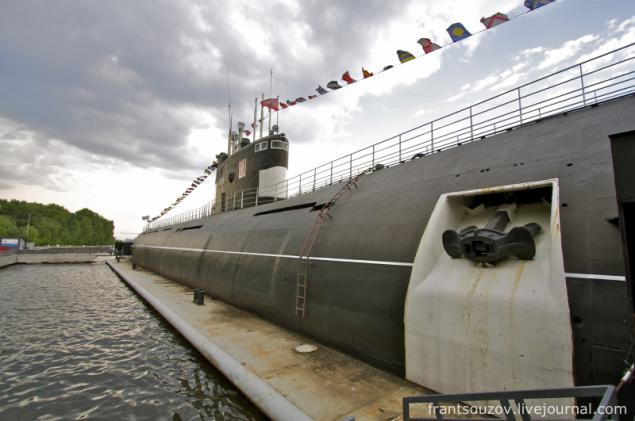
We go inside. The interior of the submarine, much has changed. The biggest discrepancy between the reality - openings in the bulkheads between the compartments of the boat so that visitors can easily walk to the museum.
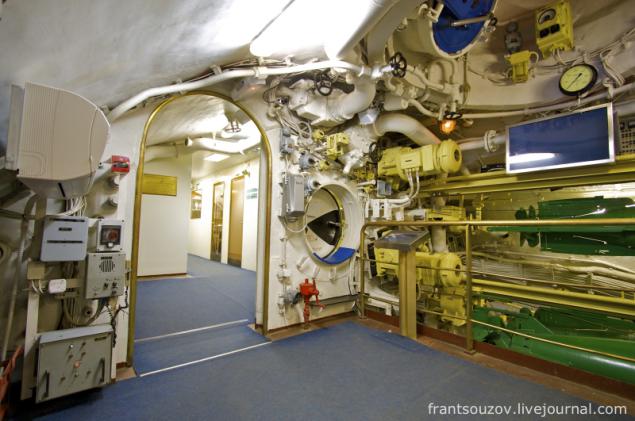
Armed with bow and stood 6 4 stern torpedo tubes caliber of 533 meters. Ammunition was 22 torpedoes or 44 mines.
Additionally, you can place a 12 torpedoes (or 24 mines) in the second compartment, at the expense of habitability.
The crew was 78 people, including 17 officers. Each member of the crew, in contrast to many other projects submarines had their own bed.
With the help of special winches for guiding the torpedo launcher was placed in the unit, and then the rear hatch closed and compressed air under high pressure torpedo that weighs several hundred kilograms, in a split second pushed out. Then it runs its engine, and she suggests the goal.
As a tour guide told us, before the site where we stand, it was not, but instead housed the ammunition, as well as personnel Sleeps - sailors literally "slept on torpedoes."
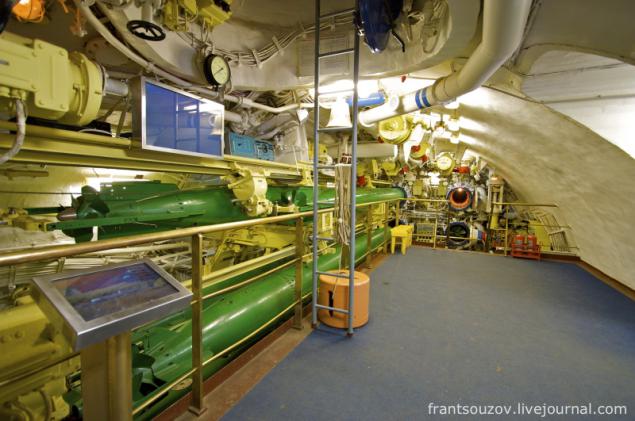
The diameter of the torpedo - exactly 533 millimeters.
Dad told us how they trained to leave the boat through the torpedo tubes (required for emergencies). In a special wetsuit, designed for greater depth of the dive, you climb into the machine, the rear hatch is closed, the camera apparatus is pumped seawater (to equalize the pressure) and then swim out. And the machine can be easily stuck (wetsuit something rather big, it is in the photo below right). In general, people with claustrophobia do not belong here.
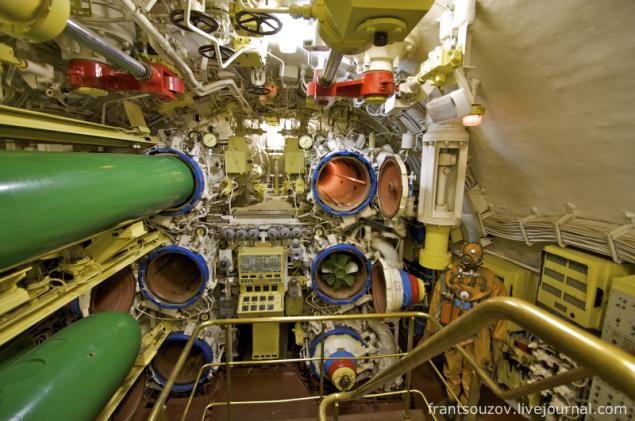
And this is one of the three hatches leading upstairs, through which were loaded into the torpedo. They were also used for emergency escape boat.
Manholes are located in the first compartment (nose), middle (the captain's cabin) and aft. Each crew member is rigidly secured their place (for example, if you are a radio operator, then you have nothing to do in the engine room). When emergency situations (such as fire or flooding) the damaged compartment is locked on both sides, even if it is not of the people managed to get out (as it is necessary for the salvation of the submarine as a whole). Consequently, the more chances to survive in those men who are in the bays, where there are emergency exits.
Leave the boat, which is under water (Operating depth - 240 meters, the maximum - 300), it is also very difficult.
Before leaving the hatch is thrown out a special buoy (float, speaking the language of land) bright orange color, which is also placed instruments to signal distress.
I tied a rope to the buoy, which every five meters (like, I do not remember the exact distance) tied knots.
When leaving the boat at the diver has a special device - the counter units - attached to the wetsuit. The basic idea is this: the ascent is counted a certain number of knots on the rope (at a time runs about 10 meters), depending on the depth, after which the counter stops, and you some time to be at a given depth. Stopwatch timed the "rest" (about 10-15 minutes), then pops up a few knots up - and so to the surface.
It is necessary for adaptation to the pressure difference between the depth and the surface. If you just float upward sharply without adaptation - the blood in the lungs immediately begins to boil and the person dies.
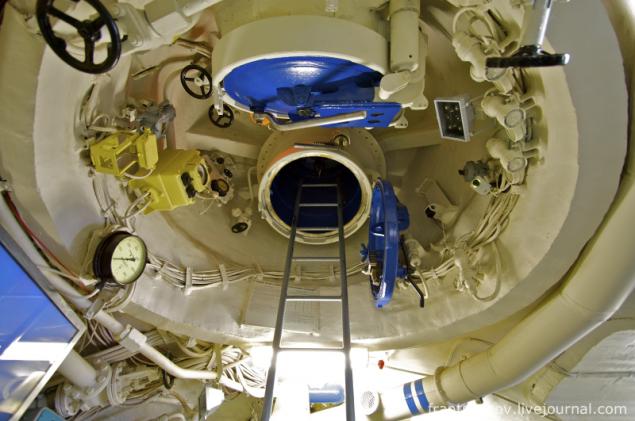
In the same compartment hanging ship's bell - bell, which is always "must shine like a bald spot at the boatswain." Since the water no day or night, the time of day is determined by the ship's bell calls every half hour, to help staff know when it's time to intrude on watch.

Between the compartments are separated by a circular hermetic hatches to withstand the pressure of 10kg per square centimeter (very much). On the hatch hanging something like Morse code, but each letter of the alphabet is encoded according to the two-digit number plate. If the connection between the compartments will be broken, you can simply tapping with.
In the center of the photo is the drive to return the armature (vertical yellow colonies).
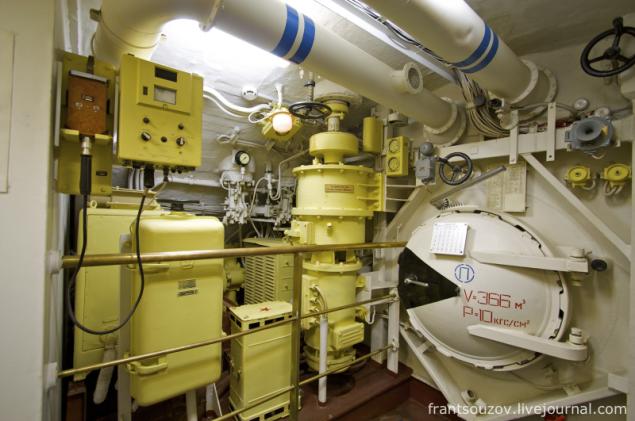
Wardroom, where food is consumed. By the way, every submariner day put 250 ml dry red wine.

Infirmary, as well as the ship's doctor's cabin.
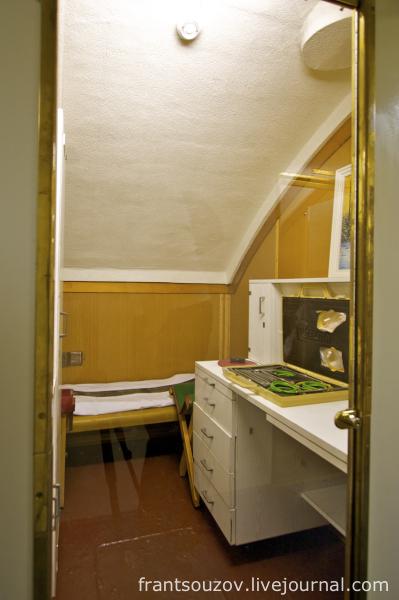
The corridor between the cabins. Unfortunately, the inputs into the closed glass.
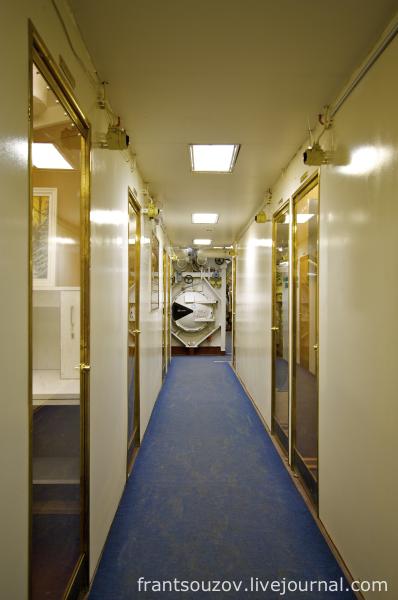
And here is the bridge on which my Dad happy photographed (during his life no one was allowed to sit in this chair). By the way, often sitting here is not the captain and the navigator, which controls the movement of the boat, and the captain was just beside.
Note the two small lamps on the ceiling - red and white. When combat duty, they were the only sources of light on the bridge, so the room was dim.
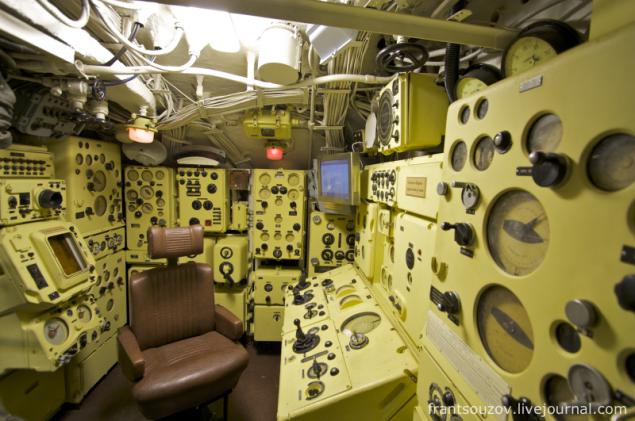
With three joysticks performed diving and surfacing (trim by the bow / stern) of the boat and turn on a certain course. Also here it was made managing speed. The gray box in the middle of modern monitors - Indicator circular scan sonar, showing the location of possible targets.
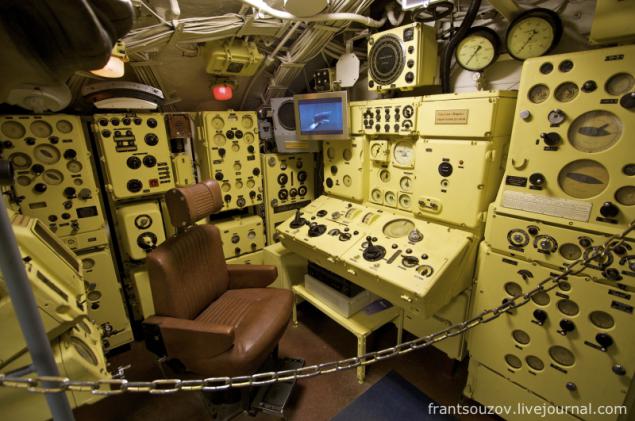
The control system of high pressure air station (WSC) for blowing ballast. On a submarine, there are special containers, known as ballast tanks, which are equipped with larger valves (Kingston) at the bottom and a vent at the top.
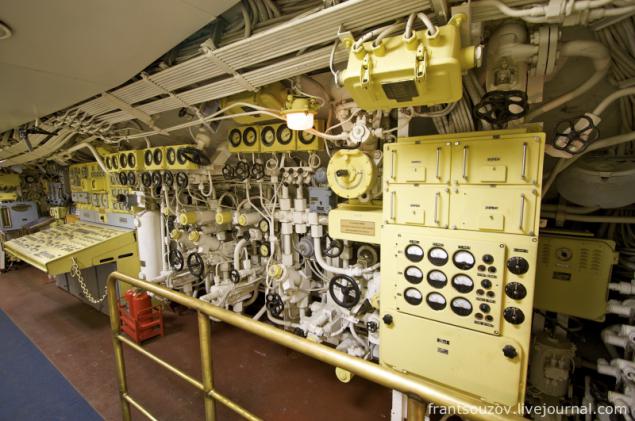
When submerged the lower and upper valves are opened, air escapes, and reservoirs for pumping water for 20-30 seconds. If nasal water tank is greater than the feed - the boat nose drops down, and vice versa.
When you ascend the top valve is closed and pumped into tanks, compressed air, water is pushed through Kingston and the boat rises up.
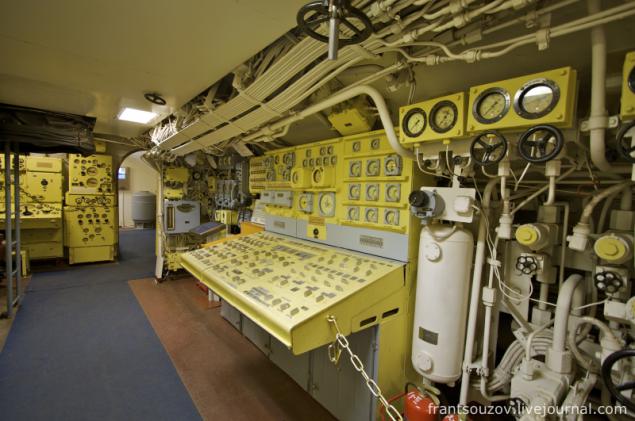
Felling radar, thanks to the equipment which the ship is guided underwater and defines objectives.
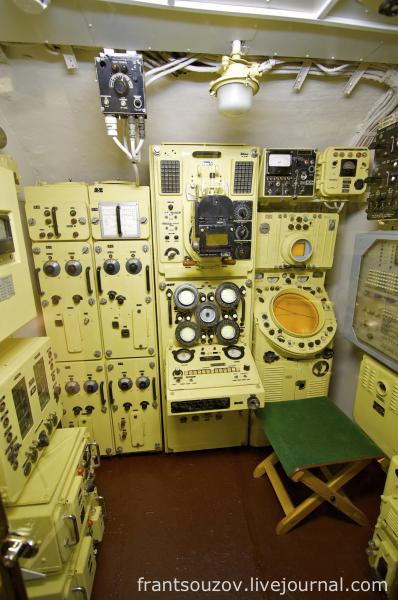
In one of the compartments has a detailed layout of the submarine, but unfortunately I have not had time to consider it.
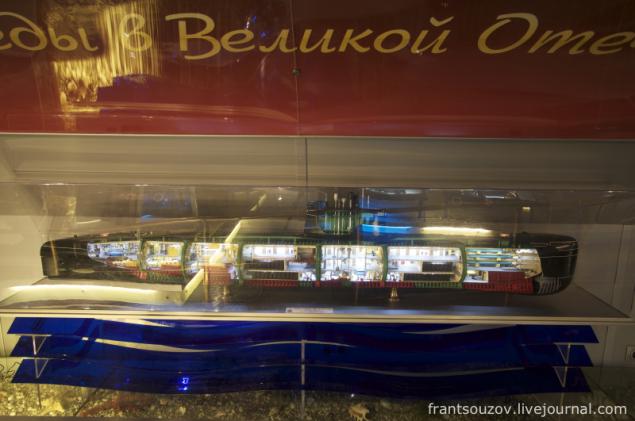
Numerous equipment inside. By the way, the total length of wire is 250 thousand kilometers!

Then we go into the engine compartment. Since this diesel-electric submarine, there are three types of diesel engine 2D42.
For the diesel engine needs air (large white pipe intake leads upstairs), so that the motors work only for the ascent of the boat.
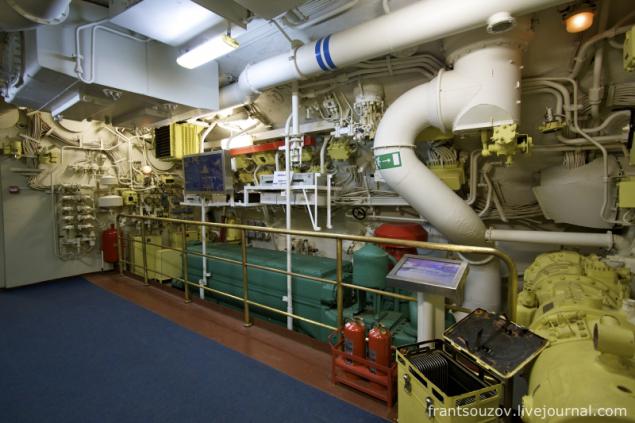
The capacity of each engine is 1900 horsepower! When the roar was such that within an hour mechanic could lose their hearing for life, so the use of personal protective equipment.

Diesel engines, in turn rotates electric generators located next compartment. Generators were charging 4 batteries of 112 elements each, which fed motors, driving the screws.
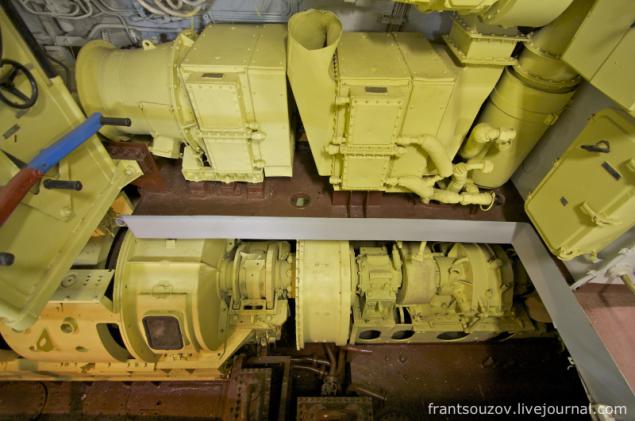
The aft compartment, which contained the engines and the crew berths.
The boat was found several electric motors: two onboard to 1350 hp each (type PG101), one average of 2,700 hp (PG102), as well as the engine of economic progress 140 hp (PG104).
Surface speed stroke was 13 knots (about 25 km / h), underwater - 16 knots (about 30 km / h).
Cruising range - 450 miles submerged, 14,000 miles on the surface.
Autonomy - 80 days under water, and then ascend needed to replenish the air.
The red stuff on the bottom right - something like a jack, damaged casing hole on the inside superimposed "patch" held by this spacer.
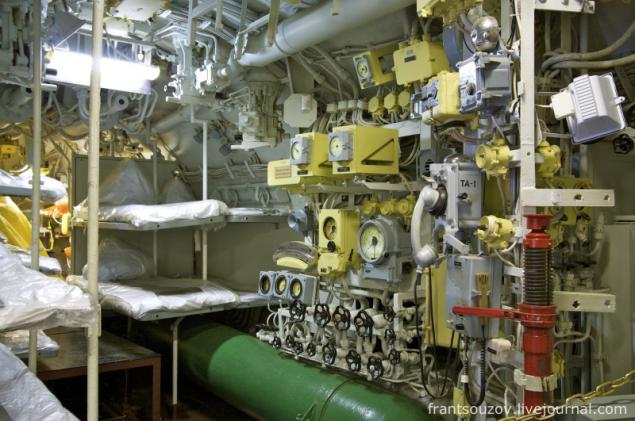
Node intercom on the ship. There is the spirit of steampunk.
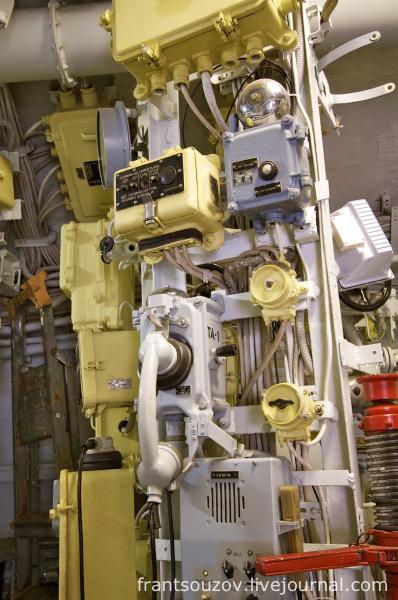
Next we went outside, and the girl-guide allowed us to go to the territory, closed for the rest of the museum visitors.
In the photo - amphibious assault hovercraft "Scat" project in 1205, in 1969-1974. 29 units were built.
The boat was designed for the transport by sea of advanced units and troops landing them unequipped coast.
Two ships were also used for search and rescue crews of spacecraft in case of water landing in the Aral Sea (with the deflection of the settlement).
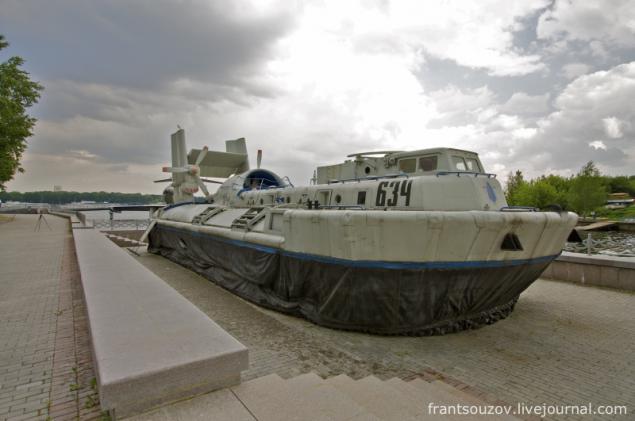
On his arms were four 30-mm grenade AP-30 and 7.62-mm machine gun. Displacement is 22 tons, the size - 21.4 by 7.3 meters.
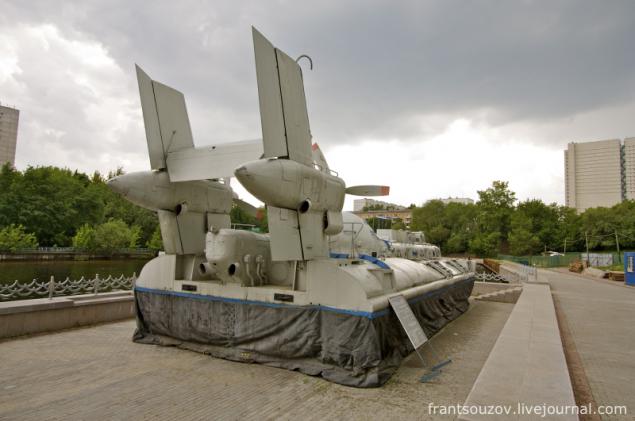
To drive the propellers used two engines capacity of 780 hp each, while the blower air cushion - one engine at the same Force 780.
Speed - 50 knots, the crew - 4 people, with the boat could take on board up to 40 paratroopers.

And finally - winged "Eaglet" Project 904, built in 1984.
Of the advantages - flights at air speeds at high fuel efficiency, the possibility of landing on land / sea / ice / shallow water / in the high seas. Radar stealth, surprise, operational application (able to fly at altitudes up to 3000 meters), a large capacity (20 tons). Unfortunately, despite the outstanding performance, it was built only 3 units ...
via
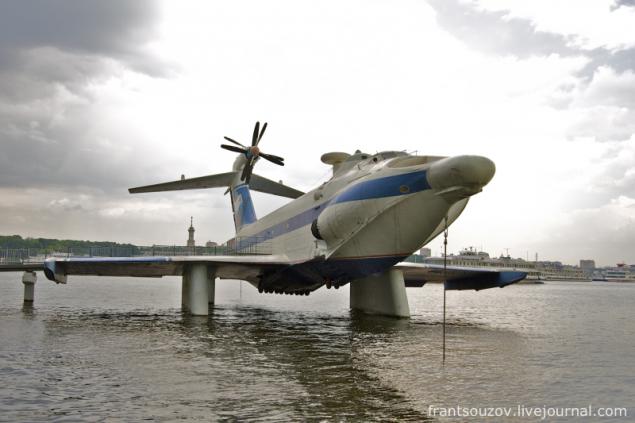
Source:
A detailed photo report on the visit of the submarine by blogger Frantsuzova Denis.
In 2006, the year in the Northern Tushino on the banks of the Khimki reservoir was opened museum, located in this diesel-electric submarine with hull number B-396 641-B of the project, he served from 1981 in the battle of the Northern Fleet.
The boat was built in 1980 at the plant "Red Sormovo" in Nizhny Novgorod.
Its surface displacement - 2770 tons, underwater - 3,600 tons.
Length - 90, 2 m, width - 8, 6 m, draft of 5, 7 m.

During duty committed war patrol boat in the Mediterranean Sea, and patrolled by Soviet and Russian borders in the Barents and Norwegian Seas, was repeatedly named the best ship of the Northern Fleet.
After her write-off in 1998 from the Navy the ship was bought by the Moscow authorities, together with the escort ship "Friendly» №754 as exhibits of the future museum of the history of the domestic fleet and shipbuilding in Moscow.

We go inside. The interior of the submarine, much has changed. The biggest discrepancy between the reality - openings in the bulkheads between the compartments of the boat so that visitors can easily walk to the museum.

Armed with bow and stood 6 4 stern torpedo tubes caliber of 533 meters. Ammunition was 22 torpedoes or 44 mines.
Additionally, you can place a 12 torpedoes (or 24 mines) in the second compartment, at the expense of habitability.
The crew was 78 people, including 17 officers. Each member of the crew, in contrast to many other projects submarines had their own bed.
With the help of special winches for guiding the torpedo launcher was placed in the unit, and then the rear hatch closed and compressed air under high pressure torpedo that weighs several hundred kilograms, in a split second pushed out. Then it runs its engine, and she suggests the goal.
As a tour guide told us, before the site where we stand, it was not, but instead housed the ammunition, as well as personnel Sleeps - sailors literally "slept on torpedoes."

The diameter of the torpedo - exactly 533 millimeters.
Dad told us how they trained to leave the boat through the torpedo tubes (required for emergencies). In a special wetsuit, designed for greater depth of the dive, you climb into the machine, the rear hatch is closed, the camera apparatus is pumped seawater (to equalize the pressure) and then swim out. And the machine can be easily stuck (wetsuit something rather big, it is in the photo below right). In general, people with claustrophobia do not belong here.

And this is one of the three hatches leading upstairs, through which were loaded into the torpedo. They were also used for emergency escape boat.
Manholes are located in the first compartment (nose), middle (the captain's cabin) and aft. Each crew member is rigidly secured their place (for example, if you are a radio operator, then you have nothing to do in the engine room). When emergency situations (such as fire or flooding) the damaged compartment is locked on both sides, even if it is not of the people managed to get out (as it is necessary for the salvation of the submarine as a whole). Consequently, the more chances to survive in those men who are in the bays, where there are emergency exits.
Leave the boat, which is under water (Operating depth - 240 meters, the maximum - 300), it is also very difficult.
Before leaving the hatch is thrown out a special buoy (float, speaking the language of land) bright orange color, which is also placed instruments to signal distress.
I tied a rope to the buoy, which every five meters (like, I do not remember the exact distance) tied knots.
When leaving the boat at the diver has a special device - the counter units - attached to the wetsuit. The basic idea is this: the ascent is counted a certain number of knots on the rope (at a time runs about 10 meters), depending on the depth, after which the counter stops, and you some time to be at a given depth. Stopwatch timed the "rest" (about 10-15 minutes), then pops up a few knots up - and so to the surface.
It is necessary for adaptation to the pressure difference between the depth and the surface. If you just float upward sharply without adaptation - the blood in the lungs immediately begins to boil and the person dies.

In the same compartment hanging ship's bell - bell, which is always "must shine like a bald spot at the boatswain." Since the water no day or night, the time of day is determined by the ship's bell calls every half hour, to help staff know when it's time to intrude on watch.

Between the compartments are separated by a circular hermetic hatches to withstand the pressure of 10kg per square centimeter (very much). On the hatch hanging something like Morse code, but each letter of the alphabet is encoded according to the two-digit number plate. If the connection between the compartments will be broken, you can simply tapping with.
In the center of the photo is the drive to return the armature (vertical yellow colonies).

Wardroom, where food is consumed. By the way, every submariner day put 250 ml dry red wine.

Infirmary, as well as the ship's doctor's cabin.

The corridor between the cabins. Unfortunately, the inputs into the closed glass.

And here is the bridge on which my Dad happy photographed (during his life no one was allowed to sit in this chair). By the way, often sitting here is not the captain and the navigator, which controls the movement of the boat, and the captain was just beside.
Note the two small lamps on the ceiling - red and white. When combat duty, they were the only sources of light on the bridge, so the room was dim.

With three joysticks performed diving and surfacing (trim by the bow / stern) of the boat and turn on a certain course. Also here it was made managing speed. The gray box in the middle of modern monitors - Indicator circular scan sonar, showing the location of possible targets.

The control system of high pressure air station (WSC) for blowing ballast. On a submarine, there are special containers, known as ballast tanks, which are equipped with larger valves (Kingston) at the bottom and a vent at the top.

When submerged the lower and upper valves are opened, air escapes, and reservoirs for pumping water for 20-30 seconds. If nasal water tank is greater than the feed - the boat nose drops down, and vice versa.
When you ascend the top valve is closed and pumped into tanks, compressed air, water is pushed through Kingston and the boat rises up.

Felling radar, thanks to the equipment which the ship is guided underwater and defines objectives.

In one of the compartments has a detailed layout of the submarine, but unfortunately I have not had time to consider it.

Numerous equipment inside. By the way, the total length of wire is 250 thousand kilometers!

Then we go into the engine compartment. Since this diesel-electric submarine, there are three types of diesel engine 2D42.
For the diesel engine needs air (large white pipe intake leads upstairs), so that the motors work only for the ascent of the boat.

The capacity of each engine is 1900 horsepower! When the roar was such that within an hour mechanic could lose their hearing for life, so the use of personal protective equipment.

Diesel engines, in turn rotates electric generators located next compartment. Generators were charging 4 batteries of 112 elements each, which fed motors, driving the screws.

The aft compartment, which contained the engines and the crew berths.
The boat was found several electric motors: two onboard to 1350 hp each (type PG101), one average of 2,700 hp (PG102), as well as the engine of economic progress 140 hp (PG104).
Surface speed stroke was 13 knots (about 25 km / h), underwater - 16 knots (about 30 km / h).
Cruising range - 450 miles submerged, 14,000 miles on the surface.
Autonomy - 80 days under water, and then ascend needed to replenish the air.
The red stuff on the bottom right - something like a jack, damaged casing hole on the inside superimposed "patch" held by this spacer.

Node intercom on the ship. There is the spirit of steampunk.

Next we went outside, and the girl-guide allowed us to go to the territory, closed for the rest of the museum visitors.
In the photo - amphibious assault hovercraft "Scat" project in 1205, in 1969-1974. 29 units were built.
The boat was designed for the transport by sea of advanced units and troops landing them unequipped coast.
Two ships were also used for search and rescue crews of spacecraft in case of water landing in the Aral Sea (with the deflection of the settlement).

On his arms were four 30-mm grenade AP-30 and 7.62-mm machine gun. Displacement is 22 tons, the size - 21.4 by 7.3 meters.

To drive the propellers used two engines capacity of 780 hp each, while the blower air cushion - one engine at the same Force 780.
Speed - 50 knots, the crew - 4 people, with the boat could take on board up to 40 paratroopers.

And finally - winged "Eaglet" Project 904, built in 1984.
Of the advantages - flights at air speeds at high fuel efficiency, the possibility of landing on land / sea / ice / shallow water / in the high seas. Radar stealth, surprise, operational application (able to fly at altitudes up to 3000 meters), a large capacity (20 tons). Unfortunately, despite the outstanding performance, it was built only 3 units ...
via

Source:
